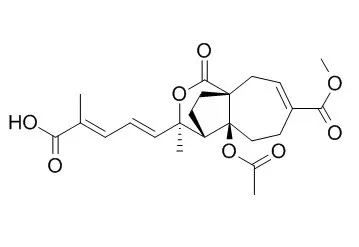| Description: |
Pseudolaric Acid B has dual antiangiogenic, anti-fungal, anti-fertility, anti-inflammatory, immunomodulatory and pro-apoptosis effects. Pseudolaric Acid B reversed the multidrug resistance of gastric neoplasm to chemotherapy drugs by downregulating the Cox-2/PKC-α/P-gp/mdr1 signaling pathway, it suppressed T lymphocyte activation through inhibition of NF-κB and p38 signaling pathways. |
| Targets: |
NF-kB | p38MAPK | P65 | COX | PKC | P-gp | HSP (e.g. HSP90) | Caspase | VEGFR | IL Receptor | PPAR | HIF | Bcl-2/Bax | Caspase |
| In vitro: |
| J Asian Nat Prod Res. 2015 Apr 21:1-10. | | Synthesis and biological evaluation of pseudolaric acid B derivatives as potential immunosuppressive agents.[Pubmed: 25895444] |
METHODS AND RESULTS:
Pseudolaric Acid B (PB) derivatives with immunosuppressive activity were found by our group. In order to find potential immunosuppressive agents with high efficacy and low toxicity, a series of novel PB derivatives were synthesized and evaluated on their immunosuppressive activities. Most of the synthesized compounds were tested in vitro on murine T and B proliferation. In particular, compound 11 exhibited excellent inhibitory activity toward murine T cells (up to 19-fold enhancement compared to that of mycophenolatemofetil) and little cytotoxicity toward normal murine spleen cells.
CONCLUSIONS:
These experimental data demonstrated that some of these PB derivatives have great potential for future immunosuppressive studies. | | Clin Cancer Res. 2004 Dec 15;10(24):8266-74. | | Pseudolaric acid B inhibits angiogenesis and reduces hypoxia-inducible factor 1alpha by promoting proteasome-mediated degradation.[Pubmed: 15623602 ] | Pseudolaric Acid B (PAB), the naturally occurring diterpenoid isolated from the root bark of Pseudolarix kaempferi Gordon tree (Pinaceae), possesses potent antifungal and pregnancy-terminating effects that may be tightly associated with angiogenesis. This study was to examine its angiogenic inhibition, impact on vascular endothelial growth factor (VEGF) secretion from tumor cells and the possible mechanism of action.
METHODS AND RESULTS:
Angiogenesis inhibition was assessed by the human umbilical vascular endothelial cell proliferation, migration, and tube-formation assays, as well as the chorioallantoic membrane assay. ELISA, reverse transcription-PCR, and Western blotting analyses were performed to examine VEGF protein secretion, mRNA expression, and the possible mechanism in hypoxic MDA-MB-468 cells.
PAB displayed potent in vitro antiangiogenic activity shown by inhibiting VEGF-stimulated proliferation and migration and fetal bovine serum-stimulated tube formation of human umbilical vascular endothelial cells in a concentration-dependent manner. Moreover, PAB (10 nmol per egg) significantly suppressed in vivo angiogenesis in the chorioallantoic membrane assay. On the other hand, PAB abrogated hypoxia-induced VEGF secretion from MDA-MB-468 cells via reducing HIF-1alpha protein. Additional analyses using LY294002 and U0126 indicated that the increase in hypoxia-inducible factor 1 (HIF-1)alpha protein level was highly dependent on phosphatidylinositol 3'-kinase and p42/p44 mitogen-activated protein kinase activities in hypoxic MDA-MB-468 cells. However, PAB treatment did not affect the active (phosphorylated) forms of Akt and Erk. Interestingly, the selective proteasome inhibitor MG-132 completely reversed the reduction of HIF-1alpha protein in the PAB-treated MDA-MB-468 cells.
CONCLUSIONS:
PAB displays the dual antiangiogenic activities of directly inhibiting endothelial cells and abrogating paracrine stimulation of VEGF from tumor cells due to reducing HIF-1alpha protein by promoting its proteasome-mediated degradation in MDA-MB-468 cells, which has potential clinical relevance. |
|
| In vivo: |
| J Cell Biochem. 2009 Sep 1;108(1):87-95 | | Pseudolaric acid B suppresses T lymphocyte activation through inhibition of NF-kappaB signaling pathway and p38 phosphorylation.[Pubmed: 19507195 ] | Pseudolaric Acid B (PAB) is a major bioactive component of the medicinal plant Pseudolarix kaempferi. Traditional medicine practitioners in Asia have been using the roots of this plant to treat inflammatory and microbial skin diseases for centuries.
METHODS AND RESULTS:
In the current study, in vitro immunosuppressive effect of PAB and the underlying mechanisms have been investigated. The results showed that PAB dose-dependently suppressed human T lymphocyte proliferation, IL-2 production and CD25 expression induced by co-stimulation of PMA plus ionomycin or of anti-OKT-3 plus anti-CD28. Mechanistic studies showed that PAB significantly inhibited nuclear translocation of NF-kappaB p65 and phosphorylation and degradation of IkappaB-alpha evoked by co-stimulation of PMA plus ionomycin. PAB could also suppress the phosphorylation of p38 in the MAPKs pathway.
CONCLUSIONS:
Based on these evidences, we conclude that PAB suppressed T lymphocyte activation through inhibition of NF-kappaB and p38 signaling pathways; this would make PAB a strong candidate for further study as an anti-inflammatory agent. | | PLoS One. 2014 Sep 24;9(9):e107830. | | The inhibitory effect of pseudolaric acid B on gastric cancer and multidrug resistance via Cox-2/PKC-α/P-gp pathway.[Pubmed: 25250794] | To investigate the inhibitory effect of Pseudolaric Acid B on subcutaneous xenografts of human gastric adenocarcinoma and the underlying molecular mechanisms involved in its multidrug resistance.
METHODS AND RESULTS:
Human gastric adenocarcinoma SGC7901 cells and drug-resistant SGC7901/ADR cells were injected into nude mice to establish a subcutaneous xenograft model. The effects of Pseudolaric Acid B with or without adriamycin treatment were compared by determining the tumor size and weight. Cyclo-oxygenase-2, protein kinaseC-α and P-glycoprotein expression levels were determined by immunohistochemistry and western blot.
Pseudolaric Acid B significantly suppressed the tumor growth induced by SGC7901 cells and SGC7901/ADR cells. The combination of Pseudolaric Acid B and the traditional chemotherapy drug adriamycin exhibited more potent inhibitory effects on the growth of gastric cancer in vivo than treatment with either Pseudolaric Acid B or adriamycin alone. Protein expression levels of cyclo-oxygenase-2, protein kinaseC-α and P-glycoprotein were inhibited by Pseudolaric Acid B alone or in combination with adriamycin in SGC7901/ADR cell xenografts.
CONCLUSIONS:
Pseudolaric Acid B has a significant inhibitory effect and an additive inhibitory effect in combination with adriamycin on the growth of gastric cancer in vivo, which reverses the multidrug resistance of gastric neoplasm to chemotherapy drugs by downregulating the Cox-2/PKC-α/P-gp/mdr1 signaling pathway. |
|






 Cell. 2018 Jan 11;172(1-2):249-261.e12. doi: 10.1016/j.cell.2017.12.019.IF=36.216(2019)
Cell. 2018 Jan 11;172(1-2):249-261.e12. doi: 10.1016/j.cell.2017.12.019.IF=36.216(2019) Cell Metab. 2020 Mar 3;31(3):534-548.e5. doi: 10.1016/j.cmet.2020.01.002.IF=22.415(2019)
Cell Metab. 2020 Mar 3;31(3):534-548.e5. doi: 10.1016/j.cmet.2020.01.002.IF=22.415(2019) Mol Cell. 2017 Nov 16;68(4):673-685.e6. doi: 10.1016/j.molcel.2017.10.022.IF=14.548(2019)
Mol Cell. 2017 Nov 16;68(4):673-685.e6. doi: 10.1016/j.molcel.2017.10.022.IF=14.548(2019)